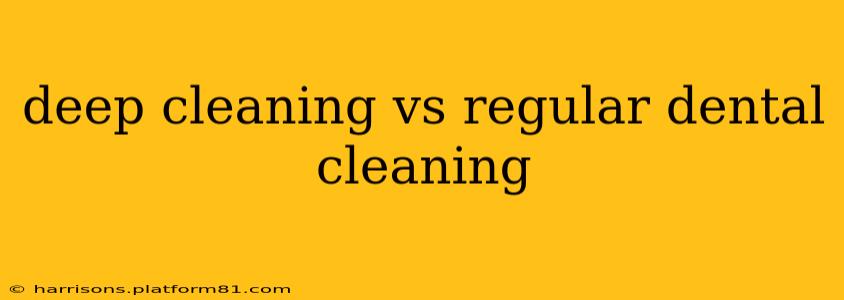Maintaining optimal oral health requires regular dental checkups and cleanings. However, the terms "deep cleaning" and "regular cleaning" often cause confusion. This article clarifies the distinctions between these two procedures, helping you understand when each is necessary and what to expect.
What is a Regular Dental Cleaning?
A regular dental cleaning, also known as a prophylaxis, is a preventative procedure typically recommended every six months. During this visit, your hygienist will perform the following:
- Removal of plaque and tartar: Plaque, a sticky film of bacteria, constantly forms on your teeth. If left undisturbed, it hardens into tartar (calculus), which can only be removed by professional cleaning. Your hygienist uses specialized instruments to meticulously scrape away both plaque and tartar from above and below the gum line.
- Polishing of teeth: After removing plaque and tartar, your teeth are polished to remove surface stains and leave your smile feeling smooth.
- Dental examination: The dentist will examine your teeth and gums, checking for any signs of cavities, gum disease, or other oral health issues. X-rays may also be taken.
- Fluoride treatment (often): A fluoride treatment helps strengthen tooth enamel and prevent cavities.
What is a Deep Cleaning (Scaling and Root Planing)?
A deep cleaning, officially called scaling and root planing, is a more extensive procedure necessary for individuals with gum disease (periodontitis or gingivitis). It addresses the deeper pockets of infection that develop between the teeth and gums. Unlike regular cleanings, deep cleanings are typically performed by a periodontist (a gum specialist) or a dentist trained in periodontal procedures. The procedure involves:
- Deep scaling: Specialized instruments are used to remove plaque and tartar from below the gum line, reaching deeper into the periodontal pockets. This is often more time-consuming than a regular cleaning.
- Root planing: The surfaces of the tooth roots are smoothed to eliminate bacteria and encourage gum tissue reattachment. This helps reduce inflammation and improve overall gum health.
- Post-operative care instructions: You'll receive detailed instructions for aftercare, including how to maintain oral hygiene to prevent reinfection.
How Often Should I Get a Deep Cleaning?
The frequency of deep cleanings depends on the severity of your gum disease and how well you maintain your oral hygiene at home. Your dentist or periodontist will determine the appropriate schedule, which may range from once a year to several times a year. Regular checkups are crucial for early detection and intervention.
What are the Signs I Need a Deep Cleaning?
Several signs indicate the need for a deep cleaning:
- Bleeding gums: Bleeding gums during brushing or flossing are a common sign of gingivitis, an early stage of gum disease.
- Swollen or red gums: Inflammation of the gums is another key indicator.
- Receding gums: If your gums are pulling away from your teeth, exposing more of the tooth root, it's a serious sign requiring professional attention.
- Persistent bad breath: While bad breath can have various causes, it's often linked to gum disease.
- Loose teeth: Advanced gum disease can weaken the supporting structures of your teeth, leading to looseness.
Does Insurance Cover Deep Cleanings?
Most dental insurance plans cover at least a portion of the cost of deep cleanings, although the coverage varies depending on the plan. It's important to check your policy details to understand your specific coverage.
What's the Difference in Cost Between a Regular Cleaning and a Deep Cleaning?
Deep cleanings typically cost significantly more than regular cleanings due to the increased time and complexity of the procedure. The exact cost will vary based on your location, the dentist or periodontist, and the extent of the treatment needed.
Can I Prevent the Need for Deep Cleanings?
Yes! Maintaining excellent oral hygiene at home is crucial in preventing gum disease and reducing the need for deep cleanings. This includes:
- Brushing twice daily: Use a soft-bristled toothbrush and fluoride toothpaste.
- Flossing daily: Remove plaque and food particles from between your teeth.
- Regular dental checkups: Schedule regular checkups and cleanings as recommended by your dentist.
- Healthy diet: Limit sugary and acidic foods and drinks.
By understanding the differences between regular and deep dental cleanings and proactively maintaining good oral hygiene, you can significantly improve your chances of keeping your gums and teeth healthy for a lifetime. Remember to consult your dentist or periodontist for personalized advice and treatment.
